Lidong Bing
FINEREASON: Evaluating and Improving LLMs' Deliberate Reasoning through Reflective Puzzle Solving
Feb 27, 2025Abstract:Many challenging reasoning tasks require not just rapid, intuitive responses, but a more deliberate, multi-step approach. Recent progress in large language models (LLMs) highlights an important shift from the "System 1" way of quick reactions to the "System 2" style of reflection-and-correction problem solving. However, current benchmarks heavily rely on the final-answer accuracy, leaving much of a model's intermediate reasoning steps unexamined. This fails to assess the model's ability to reflect and rectify mistakes within the reasoning process. To bridge this gap, we introduce FINEREASON, a logic-puzzle benchmark for fine-grained evaluation of LLMs' reasoning capabilities. Each puzzle can be decomposed into atomic steps, making it ideal for rigorous validation of intermediate correctness. Building on this, we introduce two tasks: state checking, and state transition, for a comprehensive evaluation of how models assess the current situation and plan the next move. To support broader research, we also provide a puzzle training set aimed at enhancing performance on general mathematical tasks. We show that models trained on our state checking and transition data demonstrate gains in math reasoning by up to 5.1% on GSM8K.
Finding the Sweet Spot: Preference Data Construction for Scaling Preference Optimization
Feb 24, 2025Abstract:Iterative data generation and model retraining are widely used to align large language models (LLMs). It typically involves a policy model to generate on-policy responses and a reward model to guide training data selection. Direct Preference Optimization (DPO) further enhances this process by constructing preference pairs of chosen and rejected responses. In this work, we aim to \emph{scale up} the number of on-policy samples via repeated random sampling to improve alignment performance. Conventional practice selects the sample with the highest reward as chosen and the lowest as rejected for DPO. However, our experiments reveal that this strategy leads to a \emph{decline} in performance as the sample size increases. To address this, we investigate preference data construction through the lens of underlying normal distribution of sample rewards. We categorize the reward space into seven representative points and systematically explore all 21 ($C_7^2$) pairwise combinations. Through evaluations on four models using AlpacaEval 2, we find that selecting the rejected response at reward position $\mu - 2\sigma$ rather than the minimum reward, is crucial for optimal performance. We finally introduce a scalable preference data construction strategy that consistently enhances model performance as the sample scale increases.
LongPO: Long Context Self-Evolution of Large Language Models through Short-to-Long Preference Optimization
Feb 20, 2025Abstract:Large Language Models (LLMs) have demonstrated remarkable capabilities through pretraining and alignment. However, superior short-context LLMs may underperform in long-context scenarios due to insufficient long-context alignment. This alignment process remains challenging due to the impracticality of human annotation for extended contexts and the difficulty in balancing short- and long-context performance. To address these challenges, we introduce LongPO, that enables short-context LLMs to self-evolve to excel on long-context tasks by internally transferring short-context capabilities. LongPO harnesses LLMs to learn from self-generated short-to-long preference data, comprising paired responses generated for identical instructions with long-context inputs and their compressed short-context counterparts, respectively. This preference reveals capabilities and potentials of LLMs cultivated during short-context alignment that may be diminished in under-aligned long-context scenarios. Additionally, LongPO incorporates a short-to-long KL constraint to mitigate short-context performance decline during long-context alignment. When applied to Mistral-7B-Instruct-v0.2 from 128K to 512K context lengths, LongPO fully retains short-context performance and largely outperforms naive SFT and DPO in both long- and short-context tasks. Specifically, LongPO-trained models can achieve results on long-context benchmarks comparable to, or even surpassing, those of superior LLMs (e.g., GPT-4-128K) that involve extensive long-context annotation and larger parameter scales. Our code is available at https://github.com/DAMO-NLP-SG/LongPO.
SeaExam and SeaBench: Benchmarking LLMs with Local Multilingual Questions in Southeast Asia
Feb 10, 2025Abstract:This study introduces two novel benchmarks, SeaExam and SeaBench, designed to evaluate the capabilities of Large Language Models (LLMs) in Southeast Asian (SEA) application scenarios. Unlike existing multilingual datasets primarily derived from English translations, these benchmarks are constructed based on real-world scenarios from SEA regions. SeaExam draws from regional educational exams to form a comprehensive dataset that encompasses subjects such as local history and literature. In contrast, SeaBench is crafted around multi-turn, open-ended tasks that reflect daily interactions within SEA communities. Our evaluations demonstrate that SeaExam and SeaBench more effectively discern LLM performance on SEA language tasks compared to their translated benchmarks. This highlights the importance of using real-world queries to assess the multilingual capabilities of LLMs.
ECBench: Can Multi-modal Foundation Models Understand the Egocentric World? A Holistic Embodied Cognition Benchmark
Jan 09, 2025



Abstract:The enhancement of generalization in robots by large vision-language models (LVLMs) is increasingly evident. Therefore, the embodied cognitive abilities of LVLMs based on egocentric videos are of great interest. However, current datasets for embodied video question answering lack comprehensive and systematic evaluation frameworks. Critical embodied cognitive issues, such as robotic self-cognition, dynamic scene perception, and hallucination, are rarely addressed. To tackle these challenges, we propose ECBench, a high-quality benchmark designed to systematically evaluate the embodied cognitive abilities of LVLMs. ECBench features a diverse range of scene video sources, open and varied question formats, and 30 dimensions of embodied cognition. To ensure quality, balance, and high visual dependence, ECBench uses class-independent meticulous human annotation and multi-round question screening strategies. Additionally, we introduce ECEval, a comprehensive evaluation system that ensures the fairness and rationality of the indicators. Utilizing ECBench, we conduct extensive evaluations of proprietary, open-source, and task-specific LVLMs. ECBench is pivotal in advancing the embodied cognitive capabilities of LVLMs, laying a solid foundation for developing reliable core models for embodied agents. All data and code are available at https://github.com/Rh-Dang/ECBench.
VideoRefer Suite: Advancing Spatial-Temporal Object Understanding with Video LLM
Jan 08, 2025Abstract:Video Large Language Models (Video LLMs) have recently exhibited remarkable capabilities in general video understanding. However, they mainly focus on holistic comprehension and struggle with capturing fine-grained spatial and temporal details. Besides, the lack of high-quality object-level video instruction data and a comprehensive benchmark further hinders their advancements. To tackle these challenges, we introduce the VideoRefer Suite to empower Video LLM for finer-level spatial-temporal video understanding, i.e., enabling perception and reasoning on any objects throughout the video. Specially, we thoroughly develop VideoRefer Suite across three essential aspects: dataset, model, and benchmark. Firstly, we introduce a multi-agent data engine to meticulously curate a large-scale, high-quality object-level video instruction dataset, termed VideoRefer-700K. Next, we present the VideoRefer model, which equips a versatile spatial-temporal object encoder to capture precise regional and sequential representations. Finally, we meticulously create a VideoRefer-Bench to comprehensively assess the spatial-temporal understanding capability of a Video LLM, evaluating it across various aspects. Extensive experiments and analyses demonstrate that our VideoRefer model not only achieves promising performance on video referring benchmarks but also facilitates general video understanding capabilities.
2.5 Years in Class: A Multimodal Textbook for Vision-Language Pretraining
Jan 03, 2025



Abstract:Compared to image-text pair data, interleaved corpora enable Vision-Language Models (VLMs) to understand the world more naturally like humans. However, such existing datasets are crawled from webpage, facing challenges like low knowledge density, loose image-text relations, and poor logical coherence between images. On the other hand, the internet hosts vast instructional videos (e.g., online geometry courses) that are widely used by humans to learn foundational subjects, yet these valuable resources remain underexplored in VLM training. In this paper, we introduce a high-quality \textbf{multimodal textbook} corpus with richer foundational knowledge for VLM pretraining. It collects over 2.5 years of instructional videos, totaling 22,000 class hours. We first use an LLM-proposed taxonomy to systematically gather instructional videos. Then we progressively extract and refine visual (keyframes), audio (ASR), and textual knowledge (OCR) from the videos, and organize as an image-text interleaved corpus based on temporal order. Compared to its counterparts, our video-centric textbook offers more coherent context, richer knowledge, and better image-text alignment. Experiments demonstrate its superb pretraining performance, particularly in knowledge- and reasoning-intensive tasks like ScienceQA and MathVista. Moreover, VLMs pre-trained on our textbook exhibit outstanding interleaved context awareness, leveraging visual and textual cues in their few-shot context for task solving~\footnote{Our code are available at \url{https://github.com/DAMO-NLP-SG/multimodal_textbook}}.
M-Longdoc: A Benchmark For Multimodal Super-Long Document Understanding And A Retrieval-Aware Tuning Framework
Nov 09, 2024Abstract:The ability to understand and answer questions over documents can be useful in many business and practical applications. However, documents often contain lengthy and diverse multimodal contents such as texts, figures, and tables, which are very time-consuming for humans to read thoroughly. Hence, there is an urgent need to develop effective and automated methods to aid humans in this task. In this work, we introduce M-LongDoc, a benchmark of 851 samples, and an automated framework to evaluate the performance of large multimodal models. We further propose a retrieval-aware tuning approach for efficient and effective multimodal document reading. Compared to existing works, our benchmark consists of more recent and lengthy documents with hundreds of pages, while also requiring open-ended solutions and not just extractive answers. To our knowledge, our training framework is the first to directly address the retrieval setting for multimodal long documents. To enable tuning open-source models, we construct a training corpus in a fully automatic manner for the question-answering task over such documents. Experiments show that our tuning approach achieves a relative improvement of 4.6% for the correctness of model responses, compared to the baseline open-source models. Our data, code, and models are available at https://multimodal-documents.github.io.
Chain of Ideas: Revolutionizing Research Via Novel Idea Development with LLM Agents
Oct 25, 2024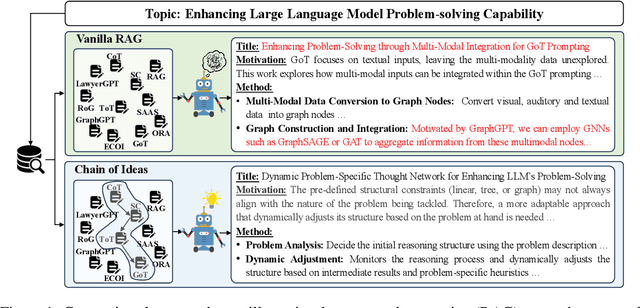

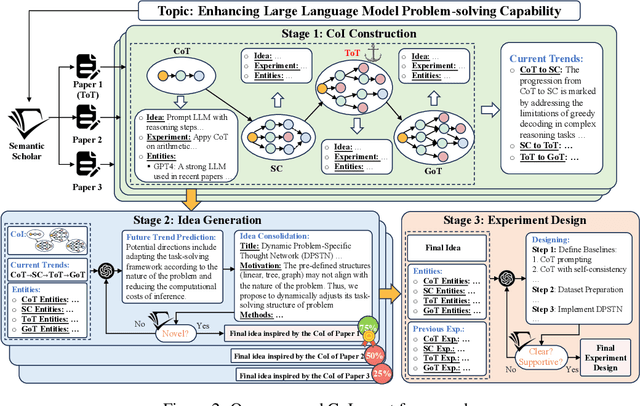

Abstract:Effective research ideation is a critical step for scientific research. However, the exponential increase in scientific literature makes it challenging for researchers to stay current with recent advances and identify meaningful research directions. Recent developments in large language models~(LLMs) suggest a promising avenue for automating the generation of novel research ideas. However, existing methods for idea generation either trivially prompt LLMs or directly expose LLMs to extensive literature without indicating useful information. Inspired by the research process of human researchers, we propose a Chain-of-Ideas~(CoI) agent, an LLM-based agent that organizes relevant literature in a chain structure to effectively mirror the progressive development in a research domain. This organization facilitates LLMs to capture the current advancements in research, thereby enhancing their ideation capabilities. Furthermore, we propose Idea Arena, an evaluation protocol that can comprehensively evaluate idea generation methods from different perspectives, aligning closely with the preferences of human researchers. Experimental results indicate that the CoI agent consistently outperforms other methods and shows comparable quality as humans in research idea generation. Moreover, our CoI agent is budget-friendly, with a minimum cost of \$0.50 to generate a candidate idea and its corresponding experimental design.
Breaking the Memory Barrier: Near Infinite Batch Size Scaling for Contrastive Loss
Oct 22, 2024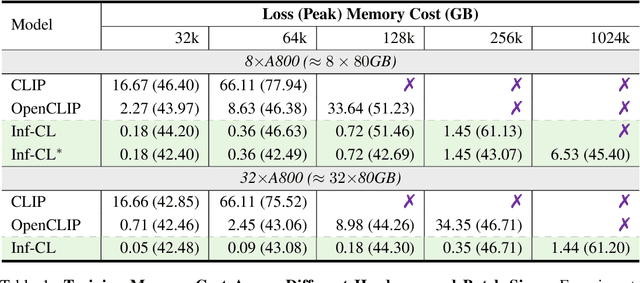
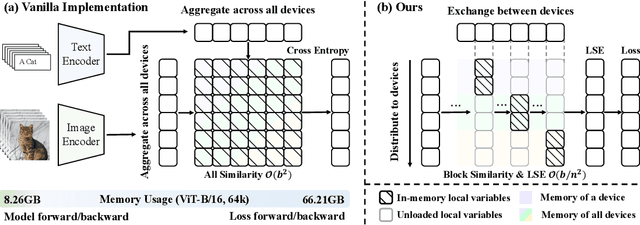
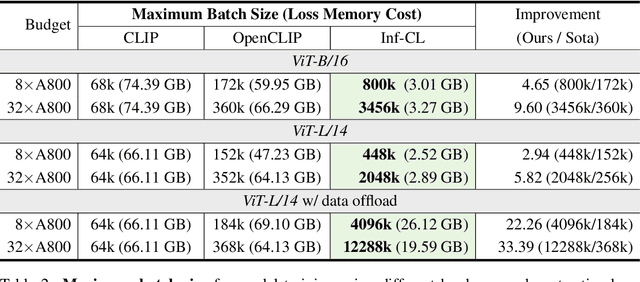
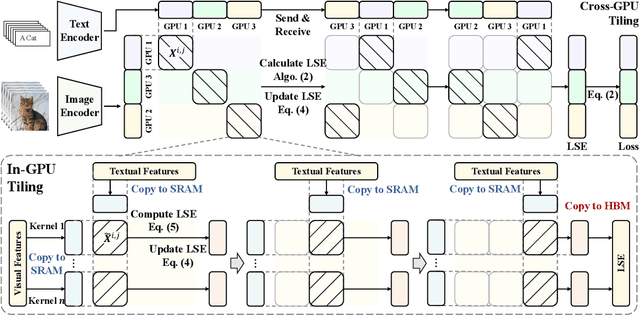
Abstract:Contrastive loss is a powerful approach for representation learning, where larger batch sizes enhance performance by providing more negative samples to better distinguish between similar and dissimilar data. However, scaling batch sizes is constrained by the quadratic growth in GPU memory consumption, primarily due to the full instantiation of the similarity matrix. To address this, we propose a tile-based computation strategy that partitions the contrastive loss calculation into arbitrary small blocks, avoiding full materialization of the similarity matrix. Furthermore, we introduce a multi-level tiling strategy to leverage the hierarchical structure of distributed systems, employing ring-based communication at the GPU level to optimize synchronization and fused kernels at the CUDA core level to reduce I/O overhead. Experimental results show that the proposed method scales batch sizes to unprecedented levels. For instance, it enables contrastive training of a CLIP-ViT-L/14 model with a batch size of 4M or 12M using 8 or 32 A800 80GB without sacrificing any accuracy. Compared to SOTA memory-efficient solutions, it achieves a two-order-of-magnitude reduction in memory while maintaining comparable speed. The code will be made publicly available.
 Add to Chrome
Add to Chrome Add to Firefox
Add to Firefox Add to Edge
Add to Edge